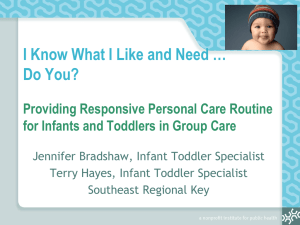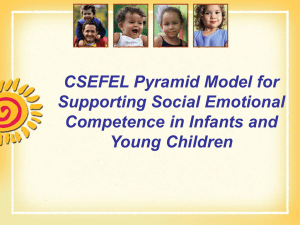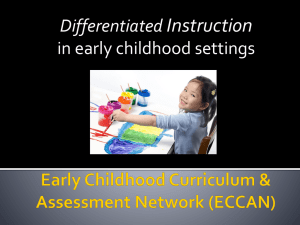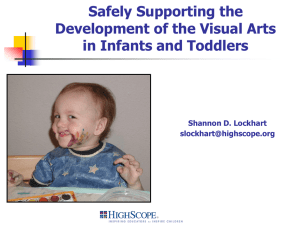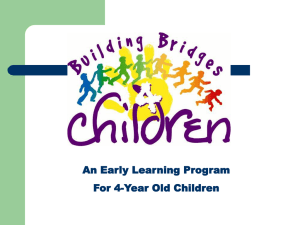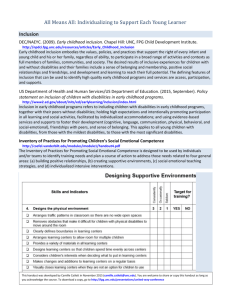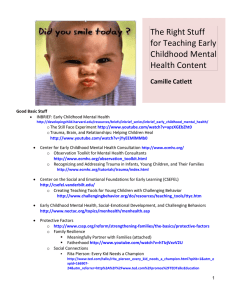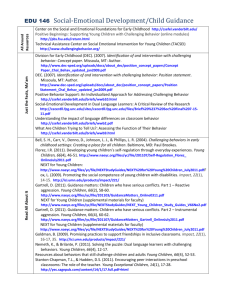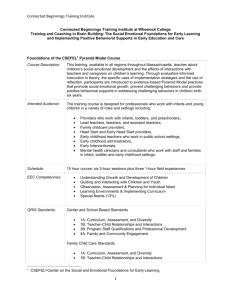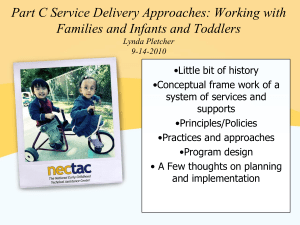BUILDING SOCIAL EMOTIONAL HEALTH
advertisement
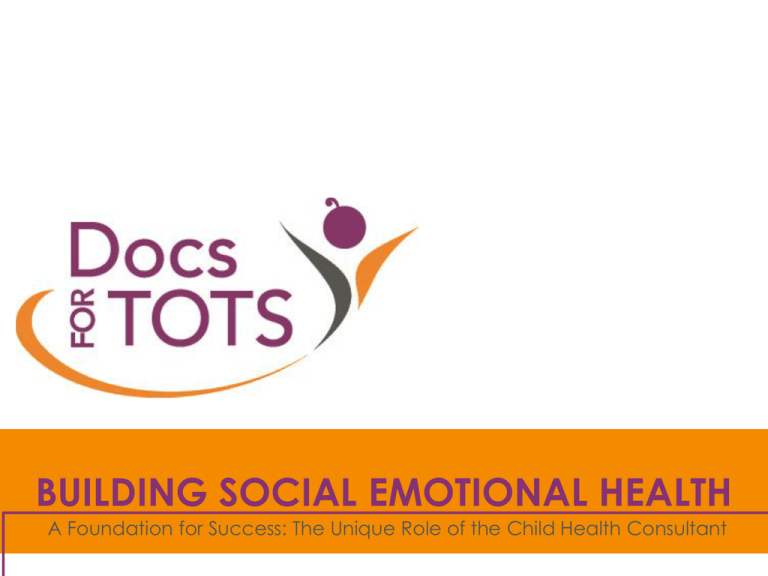
BUILDING SOCIAL EMOTIONAL HEALTH A Foundation for Success: The Unique Role of the Child Health Consultant GOALS • To identify the unique roles and opportunities for child care health consultant to promote social emotional health • To understand the compelling case for social emotional health promotion in early childhood • To identify concrete next steps and tools to integrate into practice The Foundation of a Successful Society is Built in Early Childhood Successful Parenting of Next Generation Educational Achievement Economic Productivity Responsible Citizenship Lifelong Health 3 Source: Center on the Developing Child at Harvard University (2011). INFANT MENTAL HEALTH “The developing capacity of the children from birth to 3 to experience, regulate, and express emotions; form close and secure interpersonal relationships; and explore the environment and learn – all in the context of family, community, and cultural expectations for young children.” Zero to Three, 2002 CHILD CARE HEALTH CONSULTANT • Access to setting including providers and parents • Trusted • There already…can you add this lens? • Pair & Share: Can you share a moment when you did or saw an opportunity to address social emotional health? 700 New Neural Connections Every Second Image source: Conel, JL. The postnatal development of the human cerebral cortex. Cambridge, Mass: Harvard University Press, 1959 6 700 NEW NEURAL CONNECTIONS EVERY SECOND FOUNDATION FOR EXECUTIVE FUNCTION SKILLS IS BUILD IN EARLY CHILDHOOD • Self-Control – ability to filter thoughts and impulses to resist temptations and distractions • Working Memory – ability to hold and manipulate information in our heads over short periods of time • Mental Flexibility – adjusting to changing demands, priorities, or perspectives CRITICAL FACTORS IN DEVELOPING A STRONG FOUNDATION FOR EXECUTIVE FUNCTION SKILLS • Children’s Relationships– consistent reliable adults who support and protect them, and model and engage them in building executive function skills • Activities – the opportunity to engage in activities that reduce stress, foster social connection, incorporate vigorous physical activity, and increase the complexity of skills at the right speed for each child • A safe and stable environment WHAT’S THE BIG IDEA? WHY SO IMPORTANT • Scope of social emotional/ behavioral issues • Expulsion rates • Teacher turnover • Tools and techniques that work • Impact on school success/ failure • Lifelong health BARRIERS TO EDUCATIONAL ACHIEVEMENT EMERGE AT A VERY YOUNG AGE Cumulative Vocabulary (Words) 1200 1000 College Educated Parents 800 600 Working Class Parents Welfare Parents 400 200 16 mos. 24 mos. Child’s Age (Months) 36 mos. CARING FOR OUR CHILDREN STANDARD 2.1.1.1 INTERACTIONS WITH INFANTS AND TODDLERS • Caregivers/Teachers should provide consistent , continuous and inviting opportunities to talk, listen to and otherwise interact with young infants throughout the day (indoors and outdoors) including feeding, changing, playing with, and cuddling them • **RICHNESS OF LANGUAGE • The social and emotional communications and the atmosphere and essential SERVE & RETURN BUILDS BRAINS & SKILLS • Ongoing, reliable interaction with trusted adults is essential for the development of healthy brain circuits • Systems that support the quality of relationships in early care settings, communities, and homes help build brain architecture KEY FACTORS • A language rich environment • Warm, responsive interactions between caregivers/ staff and children • Video clip examplehttp://csefel.vanderbilt.edu/resou rces/inftodd/mod1/1-1.mpg PAIR AND SHARE • Example of when this went right or wrong during your observation • Strategies for promoting serve and return/ language rich interactions EARLY CHILDHOOD STRESS INFLUENCES DEVELOPMENTAL OUTCOMES • Brief increases in heart rate, mild elevations in stress hormone levels; important to development in the context of stable and supportive relationships • Serious and temporary, but impact buffered by supportive relationships and safe environments • Prolonged activation of stress response systems in the absence of protective relationships; disrupts brain architecture, increases the risk of stress-related physical and mental illness Harvard center on the Developing Child Positive Stress Response Tolerable Stress Response Toxic Stress Response PREVELENCE OF ADVERSE CHILDHOOD EXPERIENCES (ACE) Girls Boys Total (n=9,367)(n=7,970) (17,337) 13.1% 7.6% 10.6% 27.0% 29.9% 28.3% 24.7% 16.0% 20.7% • Abuse – Emotional – Physical – Sexual • Household Dysfunction – Mother Treated Violently 13.7% – Household Substance Abuse 29.5% – Household Mental Illness 23.3% – Parental Separation or Divorce24.5% – Incarcerated Household Member 4.7% • Neglect * – Emotional 16.7% – Physical 9.2% 11.5% 23.8% 14.8% 21.8% 5.2% 12.7% 26.9% 19.4% 23.3% 4.1% 12.4% 10.7% 14.8% 9.9% *Wave 2 data only (n=8,667) Source: Kaiser ACE Study, 1 995-1997. Data from : www.cdc.gov/nccdphp/ace/demographics Children with Developmental Delays PREVELENCE OF ADVERSE CHILDHOOD EXPERIENCES (ACE) 100% 80% 60% 40% 20% Number of Risk Factors Data Source: Barth, et al. (2008) Graphic adapted from 2011, Center on the Developing Child at Harvard University 3:1 ODDS OF ADULT HEART DISEASE AFTER 7-8 ADVERSE CHILDHOOD EXPERIENCES 3.5 Odds Ratio 3 2.5 2 1.5 1 0.5 0 1 2 3 4 5,6 Adverse Experiences 7,8 UNDERSTANDING IMPACT OF ADVERSE CHILDHOOD EXPERIENCES Death Early Death Disease & Disability Adoption of Health-Risk Behaviors Social, Emotional, and Cognitive Impairment Conception Adverse Childhood Experiences Freely reproducible slide from the Centers for Disease Control and Prevention. RELATIONSHIPS BUFFER TOXIC STRESS • Learning how to cope with moderate, short-lived stress can build a healthy stress response system • Toxic stress (when the body’s stress response system is activated excessively) can weaken brain architecture • Without caring adults to buffer children, toxic stress can have long-term consequences for learning, behavior, and both physical and mental health Harvard Center on The Developing Child CFOC 2.1.2.1 PERSONAL CAREGIVER/TEACHER RELATIONSHIPS FOR INFANTS AND TODDLERS • Hold and comfort children who are upset • Engage in frequent, multiple and rich social interchanges such as smiling, talking, touching, singing and eating • Be play partners as well as protectors • Be attuned to children’s feelings and reflect them back • Communicate consistently with parents/guardians • Interact with children and develop relationship in the context of everyday routines (diapering/feeding etc.) HELPING CAREGIVERS UNDERSTAND TEMPERAMENT • • • • • • • • • Activity level – always active or generally still Biological rhythms – predictability of hunger, sleep, elimination Approach/withdrawal – response to new situations Mood – tendency to react with positive or negative mood, serious, fussy Intensity of reaction – energy or strength of emotional reaction Sensitivity – comfort with levels of sensory information; sound, brightness of light, feel of clothing, new tastes Adaptability – ease of managing transitions or changes Distractibility – how easily a childʼs attention is pulled from an activity Persistence – how long child continues with an activity he/she finds difficult From csefel handout on temperament traits ADDRESSSING CAREGIVER STRESS • • • • • Check in Acknowledge Empathize Reframe Commit to Plan Video clip portraying caregiver perceptions: http://csefel.vanderbilt.edu/resources/inftodd/mod1/1-4.mpg STRATEGY FOR EARLY CHILDHOOD SETTINGS AND PARENT EDUCATION Read together every day (your) Rhyme play and cuddle with your child every Routines Reward your child with praise for successes to build self-esteem and promote positive behavior • Develop a strong and nurturing Relationship with your child as the foundation for their healthy development • • • • PROGRAM SUPPORT FOR STRENGTHENING RELATIONSHIPS Adequate adult to child ratios Small group sizes One primary caregiver per child Continuity of care; one caregiver over time • Time for parents/guardians to share information • Time for caregivers to get to know the child through observation • • • • The National Training Institute for Child Care Health Consultants MAKE DAILY ROUTINES PREDICTABLE • Post pictures or other visual cues about what comes next. • Alternate small and large group activities, as well as quiet and highenergy activities. • Allow clear choices between activities. • Create rules and rituals that are easy to follow. The National Training Institute for Child Care Health Consultants STRATEGIES TO SUPPORT ROUTINES FOR INFANTS AND TODDLERS • Use first/next or first/then words • Display an item, such as a new toy, photo or plant, that children and families can explore together during arrival • Sing or play lullabies • Involve children in routines – for example, invite toddlers to help pass items to the next person during mealtimes WHAT IS EMOTIONAL LITERACY? • It is the capacity to: – Identify, understand and express emotion in a healthy way – Recognize, label, and understand feelings in self and others Adapted from Craddling Literacy 2007 STRATEGIES TO DEVELOP EMOTIONAL LITERACY IN INFANTS AND TODDLERS • Use the adult/child relationship to expand children’s awareness of emotions or feelings: – Verbally acknowledge and label emotions expressed by children in care – Assist infants and toddlers with regulating their emotions – Talk about the fact that feelings can change – Use questions about feelings to see if and how a child responds CSEFEL MODULE 2 STRATEGIES TO DEVELOP EMOTIONAL LITERACY IN INFANTS AND TODDLERS • Use enriching language tools: – Choose books, music, finger plays with a rich vocabulary of feeling words – Use puppetry or felt board stories that retell common social experiences and emphasize feeling vocabulary and conflict resolution – Read stories about characters that children can identify with who express a range of feelings CSEFEL MODULE 2 SOCIAL EMOTIONAL HEALTH PROMOTION: CURRICULUM • Building Executive Function • Building Health DEVELOPMENT OF PLAY SKILLS FOR INFANTS AND TODDLERS (CSEFEL MODULE 2) Age Play 13 to 24 Months • Enjoys play with objects • Increased interest in watching other children play (onlooker) • Primarily plays alone (solitary) • May offer toys to caregiver or other children • May choose independent play close to other children (parallel) but not interact with them 25-36 Months • May play with other children but in an occasional or limited way (associative) • Some cooperation and talking with other children • May take leader/follower roles in play • Some pretend play • Still plays alone frequently • Interactive level moving toward (cooperative play) SETTING UP THE ENVIRONMENT FOR DEVELOPING PLAY AND FRIENDSHIP SKILLS • Evaluate the physical space to ensure that there is enough space for infants and adults to engage in social activities • Evaluate the physical environment for spaces for two or more children to enjoy side-by side activity and for adults to be close for supervision • Evaluate the daily schedule for opportunities to develop play skills each day • Provide enough materials and equipment that allow and encourage two or more children to interact PROMOTING THE DEVELOPMENT OF FRIENDSHIP SKILLS • Encourage toddlers to help each other and do routines together • Provide positive verbal support for play between children • Read books about friends, playing together, helping each other, etc. • Practice turn-taking and sharing DEALING WITH CHALLENGING BEHAVIOR • Not addressing sufficiently here: a separate talk • This Opens a dialogue and highlights promotion • Many Resources for challenging behavior – Including (identify/explore/action and care plans/effective in class interventions/supports/community resources and referrals/communication with medical home) • Other core area communication with parents: further training • This was meant to be an overview to promote opportunities and a promotion approach….more to follow PAIR AND SHARE • What is one thing you are going to do differently to enhance your promotion of social emotional health? • What is a challenge that you would like to address around promoting social emotional health? • What is a next step in supporting your ability to address the challenge? Action step • What is a long term goal in promoting social emotional health? And an action step to get there WHAT NEXT? • • • • Let’s build bridges! Let’s build systems! Common vision Next steps CHILDCARE HEALTH CONSULTANT NETWORK BUILDING • Bridges Between Health and Early Childhood Systems (focus on childcare health consultants as key stakeholder group/target audience) • Docs For Tots Plan to support ECCS/ Build online Resource Center/Training/ Listserv/TA • What are your thoughts? What would be helpful? TO BUILDING AND SHARING THE PYRAMID! CSEFEL A TREMENDOUS RESOURCE • Explore website: make it a GO TO RESOURCE • http://csefel.vanderbilt.edu • Training Modules: – http://csefel.vanderbilt.edu/resources/training_modu les.html • Unlimited practical caregiver resources/ classroom tools/ Strategizing tools/ parent handouts – http://csefel.vanderbilt.edu/resources/strategies.html Thank you! www.docfortots.org
